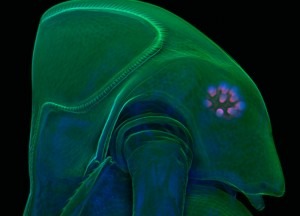
An image of a water flea by Dr Jan Michels, a zoologist at the University of Albrecht, Kiel, Germany took top prize in the 2009 Olympus Bioscapes Digital Imaging Competition.
The image reveals the exoskeleton and interior detail down to the nuclei within the flea's cells, seen as tiny, glowing blue dots.
The depiction of a whole organism detailing external and intracellular structures was selected from more than 2,000 images and films to earn the first prize, USD5,000 (GBP3,000) worth of Olympus equipment.
The Olympus Bioscapes competition specialises in images and films of human, plant and animal subjects as captured through light microscopes.
This year's winning images reflect the latest advances in neuroscience and cell biology, including the Second Prize image by Chung-Ju Rachel Wang of the University of California, Berkeley.
Her image of the nucleus of a corn plant cell shows a ladder-like protein structure called the synaptonemal complex, which forms between chromosomes during one type of cell division.
Tenth prize went to a research image of motor neurons in Amyotrophic Lateral Sclerosis, captured by Gist Croft and Mackenzie Weygandt, of New York's Columbia University and Project ALS.
The stem cells used to generate the motor neurons in the image were induced Pluripotent Stem (iPS) cells made from the skin cells of an 83-year-old ALS patient.
Studying these ALS motor neurons may allow scientists to better understand and combat the disease.
Dr Albert Pan of Harvard University took Seventh Prize with an image that uses the recently developed Brainbow imaging technique.
In his image of nerve fibres covering a larval zebrafish tail, each cell glows a distinct, random colour, allowing researchers to differentiate neighbouring cells and follow their paths.
Third Prize went to a movie called 'Sexual Attraction in Spyrogyra', by Dr Jeremy Pickett-Heaps of the University of Melbourne, Australia.
It depicts reproduction in simple algae captured in time-lapse video over two hours.
Other winning and honourable-mention images reflect the influence of science in everyday life, including views of fossils, jellyfish, spiders, flowers, mosquitoes and dinosaur bones.
20 of the 2009 winning and Honorable Mention images will be displayed at the San Diego Natural History Museum from mid-December to February 2010.
The 2009 winners' tour will continue to venues in New York City; suburban Washington DC; Philadelphia, Baltimore, and other cities.
Additional exhibits of winning BioScapes images will simultaneously be touring in cities across the US and Canada throughout 2009-10.




